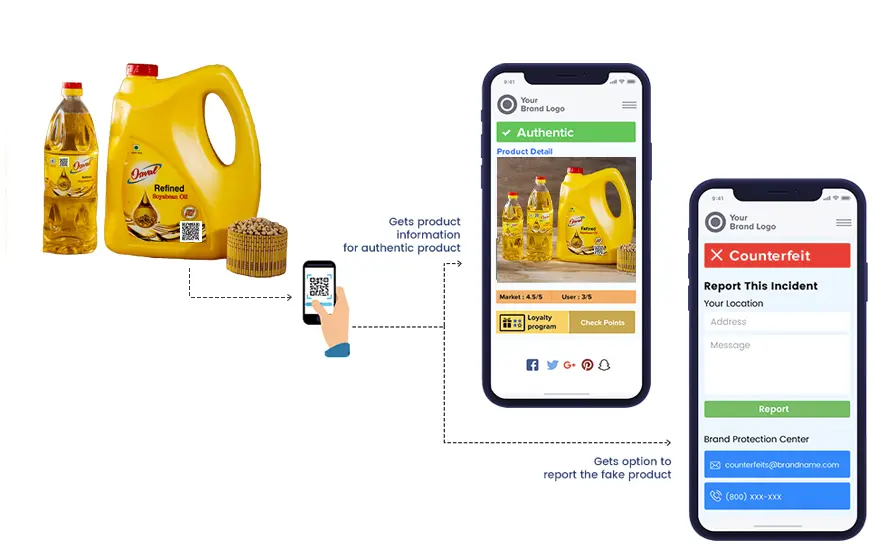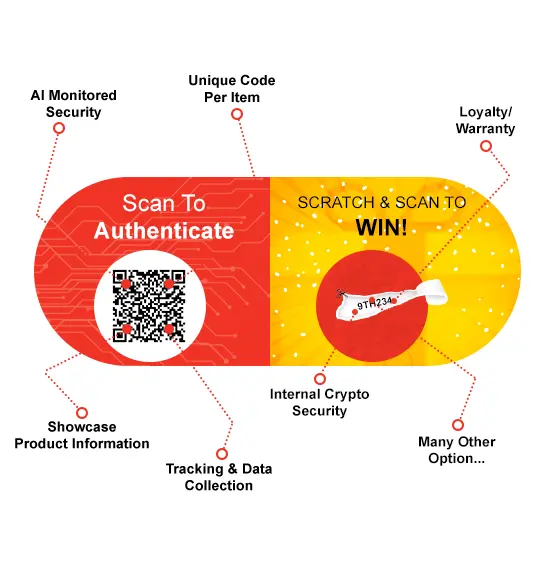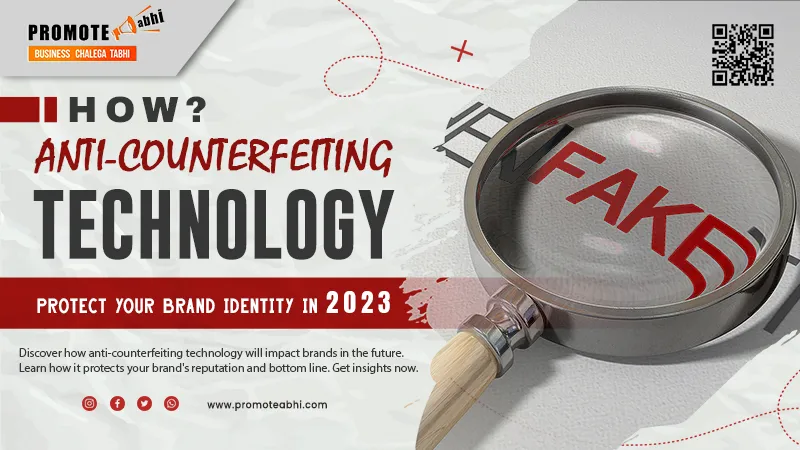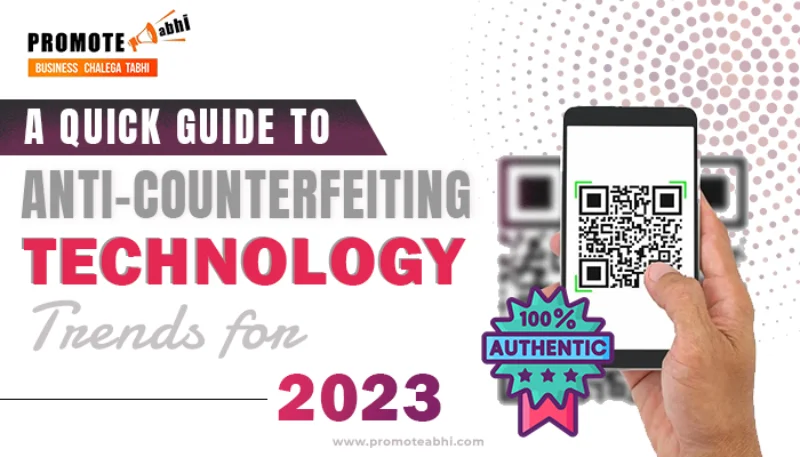One of the most effective ways to tackle counterfeiting is through anti-counterfeiting technology. In this article, we will explore the role of anti-counterfeiting technology in fighting against illicit trade. We will discuss the issues of counterfeiting products and explore some of the solutions offered by anti-counterfeiting technology. Additionally, we will delve into anti-counterfeit packaging, software, and solutions.
Some Counterfeiting Products Issues & Solutions and (How Anti-counterfeiting Technology Can Benefit Your Business?)

Counterfeiting Products Issues & Solutions
Counterfeit products pose a significant threat to consumers, businesses, and the global economy. These illicit goods can be harmful to consumers as they do not go through rigorous safety testing and can contain dangerous substances. Counterfeit medicines, for example, can be life-threatening as they do not contain the right active ingredients or dosages.
Issues Related to Counterfeiting Products
Counterfeiting products is a multi-billion-dollar industry that has evolved in sophistication over the years. From fake luxury goods to counterfeit medication, the problem of counterfeiting products is widespread and affects every industry.
Here are some of the issues related to counterfeiting products:
- Public Health and Safety: Counterfeit products pose a serious threat to public health and safety. For instance, counterfeit medication can be ineffective or even harmful, leading to serious health consequences for consumers. Similarly, counterfeit automotive parts can lead to accidents or malfunctions, putting people's lives at risk.
- Economic Losses: Counterfeit products result in significant economic losses for legitimate businesses. They not only dilute the market share but also undermine consumer confidence in genuine products. This, in turn, can lead to reduced sales and profits for legitimate businesses.
- Intellectual Property Rights: Counterfeiting products violates the intellectual property rights of legitimate businesses. It is illegal to produce and sell counterfeit products that infringe on the trademark, patent, or copyright of legitimate businesses. This violation of intellectual property rights can have serious legal consequences for counterfeiters.
- Environmental Impact: Counterfeiting products often involve the use of substandard or low-quality materials that are harmful to the environment. For example, counterfeit electronic goods may contain hazardous materials that can pollute the environment.
Solutions to Combat Counterfeiting Products
To combat the problem of counterfeiting products, several solutions are available.
Here are some of the potential solutions:
- Anti-Counterfeiting Technology: This technology can help prevent counterfeit products from entering the market. It involves using unique codes, tags, or labels attached to products that allow them to be tracked throughout the supply chain. This technology helps to identify discrepancies or suspicious activity and prevent counterfeit products from entering the market.
- Improved Regulations and Enforcement: Improved regulations and enforcement can help combat counterfeiting products. Governments can impose stricter penalties for counterfeiters, making it less profitable and riskier for them to engage in this illicit trade. Additionally, customs agencies can improve their surveillance of imported goods to prevent counterfeit products from entering the market.
- Consumer Awareness: Raising consumer awareness about the dangers of counterfeit products can also help combat this problem. Educating consumers about the risks associated with counterfeit products can help them make informed purchasing decisions and avoid buying fake products.
- Collaboration and Cooperation: Collaboration and cooperation among businesses, governments, and other stakeholders can help combat counterfeiting products. For instance, businesses can work together to share information and resources to identify and prevent counterfeit products from entering the market. Additionally, governments can work with businesses to improve regulations and enforcement to combat this problem.
Furthermore, counterfeit products harm businesses as they dilute the market share of genuine products. This, in turn, leads to decreased revenue for legitimate businesses, reduced investment in research and development, and ultimately results in job losses.
Learn more: What Is Customer Loyalty Program Software and How Does It Work?
How Anti-counterfeiting Technology Can Benefit Your Business?
Anti-counterfeiting technology offers several benefits in the fight against illicit trade.
Firstly, it helps to protect consumers by ensuring that they receive genuine products that have gone through rigorous safety testing. This can help to prevent serious health issues or even fatalities caused by counterfeit products.
Secondly, anti-counterfeiting technology helps to protect businesses by ensuring that they can compete on a level playing field. This helps to maintain the integrity of the market and prevent the dilution of market share by counterfeit products. This, in turn, leads to increased revenue for legitimate businesses, allowing them to invest in research and development and create new jobs.
Thirdly, anti-counterfeiting technology helps to protect the global economy by preventing the loss of revenue caused by counterfeit products. This revenue can be reinvested in areas such as healthcare, education, and infrastructure, helping to boost economic growth and improve the standard of living for people worldwide.

Benefits of Anti-counterfeiting Technology for Your Business
Protect Your Brand Reputation
Counterfeit products can have a detrimental effect on your brand reputation. They not only undermine consumer confidence in your products but also dilute your market share, resulting in significant economic losses. Anti-counterfeiting technology can help protect your brand reputation by preventing counterfeit products from entering the market. This, in turn, can help maintain consumer confidence in your products and increase customer loyalty.
Enhance Customer Trust and Safety
Consumer trust and safety are critical factors in the success of any business. Counterfeit products can pose a significant risk to public health and safety, leading to serious health consequences for consumers. Anti-counterfeiting technology can help ensure the safety of your customers by preventing the distribution of counterfeit products. By investing in this technology, you can demonstrate your commitment to customer safety and earn their trust.
Improve Supply Chain Efficiency
Anti-counterfeiting technology can also help improve supply chain efficiency by providing real-time visibility into the movement of products. This technology allows you to track products throughout the supply chain, from manufacturing to distribution, ensuring that they reach their intended destination. By improving supply chain efficiency, you can reduce the risk of counterfeit products entering the market and increase the speed of delivery to your customers.
Enhance Regulatory Compliance
Regulatory compliance is a critical aspect of any business. Failure to comply with regulations can result in significant legal and financial consequences. Anti-counterfeiting technology can help businesses comply with regulatory requirements by providing visibility into the movement of products. This technology allows businesses to track products throughout the supply chain, ensuring that they meet regulatory requirements.
Increase Revenue and Profitability
Counterfeit products not only undermine consumer confidence in genuine products but also result in significant economic losses for legitimate businesses. By investing in anti-counterfeiting technology, you can protect your products and brand reputation, increase customer trust and safety, improve supply chain efficiency, and enhance regulatory compliance. All of these benefits can result in increased revenue and profitability for your business.
Read about: Why Your Business Needs an Offer/coupon Management Software?
Types of Anti-counterfeiting Technology
There are several types of anti-counterfeiting technology available that businesses can use to protect their products and brand reputation.
Some of the most common types of anti-counterfeiting technology include:
Holograms and Watermarks
Holograms and watermarks are commonly used to protect high-value products such as banknotes, passports, and luxury goods. These features are difficult to replicate, making them an effective way to prevent counterfeiting.
Barcodes and QR Codes
Barcodes and QR codes are commonly used in the retail industry to track products throughout the supply chain. These codes can be scanned using a smartphone, providing real-time visibility into the movement of products.
Radio-Frequency Identification (RFID)
RFID technology involves the use of small tags or labels attached to products that can be tracked using radio waves. This technology provides real-time visibility into the movement of products and can be used to prevent the distribution of counterfeit products.
Tamper-Evident Packaging
Tamper-evident packaging is designed to show evidence of tampering if someone tries to open the packaging. This technology is commonly used in the pharmaceutical industry to prevent the distribution of counterfeit drugs.
Track and Trace Solutions
Track and trace solutions involve the use of unique codes, tags, or labels that allow products to be tracked throughout the supply chain. This technology provides real-time visibility into the movement of products, enabling businesses to identify and prevent the distribution of counterfeit products.
Digital Authentication
Digital authentication involves the use of software and apps to authenticate products. Consumers can scan a product using their smartphone to verify its authenticity. This technology provides real-time verification of products, making it difficult for counterfeiters to replicate genuine products.
By implementing anti-counterfeiting technology, businesses can ensure the authenticity of their products, increase consumer confidence, and prevent the distribution of counterfeit products. This, in turn, can lead to increased revenue and profitability, making it a worthwhile investment for any business.
How Promote Abhi’s Anti-Counterfeit Solutions to Help Prevent Counterfeiting?
Anti-counterfeit solutions involve a combination of anti-counterfeit packaging, software, and other tools to prevent counterfeit products from entering the market. These solutions are designed to be comprehensive, providing a range of measures to ensure the authenticity of products.
One example of an anti-counterfeit solution is the use of product serialization. Each product is assigned a unique serial number, which is recorded on a blockchain. This makes it easy to track the product throughout its lifecycle and ensure its authenticity.
Another example of an anti-counterfeit solution is the use of track-and-trace technology. This technology involves the use of unique codes or tags that are attached to products, allowing them to be tracked throughout the supply chain. This can help to identify any discrepancies or suspicious activity and prevent counterfeit products from entering the market.
- Anti-Counterfeit Packaging
Anti-counterfeit packaging is an essential tool in the fight against illicit trade. It is designed to make it difficult for counterfeiters to replicate the packaging of genuine products. This type of packaging can include unique features such as holograms, watermarks, or special inks that are difficult to replicate.
One example of anti-counterfeit packaging is the use of tamper-evident seals.
These seals are designed to be easily broken, making it clear if the product has been tampered with. Another example is the use of QR codes or barcodes that can be scanned to verify the authenticity of the product.
- Anti-Counterfeit Software
Anti-counterfeit software is another type of technology used to fight against counterfeit products. This software is designed to detect and prevent the production of counterfeit products by tracking the supply chain and identifying any suspicious activity.
One example of anti-counterfeit software is blockchain technology. This technology provides a secure and transparent way of tracking products throughout their lifecycle. Each transaction is recorded on a blockchain, making it impossible to tamper with the data. This makes it easier to trace the origin of a product and ensure its authenticity.
Another example of anti-counterfeit software is the use of machine learning algorithms. These algorithms can analyze large datasets and detect patterns that are indicative of counterfeit products. By analyzing data from the supply chain, machine learning algorithms can identify suspicious activity and alert relevant authorities.
Also, read this: What Is Inventory Software? And Why It’s Important for a Business?
Conclusion
In conclusion, anti-counterfeiting technology is an essential tool in the fight against illicit trade.
It offers several benefits, including protecting consumers, businesses, and the global economy. As the global supply chain becomes increasingly complex, it is essential to implement robust anti-counterfeiting measures to prevent counterfeit products from entering the market. By doing so, we can ensure a safer, more secure, and more prosperous future for everyone.


















Comments